PERU / MACHU PICCHU
June 26—July 11, 2001
THE BIG PICTURE
Getting
to and from Peru takes a while. Getting around while in Peru also takes
a while.
We
flew from Denver at about 4:00 p.m. to Miami and then overnight
to Lima
(The airport is in Callao, about 10 miles to the west on the Pacific). From Lima we flew
an hour to Cusco in
the highlands at about 11,000' and 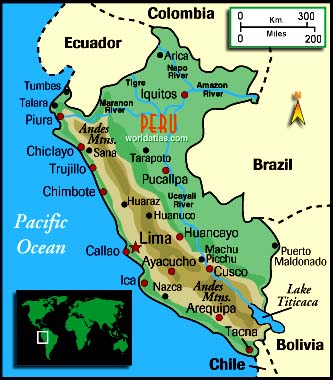 finally the last leg of 45 minutes
to Puerto
Maldonado, a town of about 30,000 situated on the Rio Madre de Dios
near the borders of Brasil and Bolivia. After three days at
the Lake Sandoval Lodge in the Amazon rain forest,
we returned to Cusco where we explored the city (of about 250,000) and
the Sacred
Valley for four days. A train took us up the Urubamba River to Kilometer
88 where we began our four day hike on
the Inca
Trail (called the most popular hike in the world)
to Machu
Picchu, the most visited attraction in South America. After two days
at the Inca city, we returned to Cusco by train and bus for a day of R
& R. On our final day we flew to Lima for a city tour and farewell
dinner before boarding the plane for Dallas–Ft. Worth and on to Denver.
finally the last leg of 45 minutes
to Puerto
Maldonado, a town of about 30,000 situated on the Rio Madre de Dios
near the borders of Brasil and Bolivia. After three days at
the Lake Sandoval Lodge in the Amazon rain forest,
we returned to Cusco where we explored the city (of about 250,000) and
the Sacred
Valley for four days. A train took us up the Urubamba River to Kilometer
88 where we began our four day hike on
the Inca
Trail (called the most popular hike in the world)
to Machu
Picchu, the most visited attraction in South America. After two days
at the Inca city, we returned to Cusco by train and bus for a day of R
& R. On our final day we flew to Lima for a city tour and farewell
dinner before boarding the plane for Dallas–Ft. Worth and on to Denver.
GREAT TRIP #5
Judy and I have been fortunate
to have traveled a good bit during our 40 years of marriage: most of the
US (we have missed North Dakota); Canada, Mexico and the Caribbean; parts of Europe;
Australia and New Zealand. Looking back, we have enjoyed what truly have
been, for us, four Great Trips: the UK and Ireland (1982), rafting the
Grand Canyon (1995), Mexico’s Copper
Canyon (1998), and Australia
/ New Zealand
/ Fiji
(1999). Our two weeks in Peru, particularly hiking the Inca
Trail and discovering for ourselves Machu Picchu, has been an experience
that we consider Great Trip #5.
“In
the variety of its charms and the power of its spell, I know of no place
in the world which can compare with it. Not only has it great snow peaks
looming above the clouds more than two miles overhead, gigantic precipices
of many–colored granite rising sheer for thousands of feet above the foaming,
glistening, roaring rapids; it has also, in striking contrast, orchids
and tree ferns, the delectable beauty of luxurious vegetation, and the
mysterious witchery of the jungle.” (Hiram Bingham)
Machu
Picchu is a destination that Judy has talked about for years. Our first
thought was to sign on with Elderhostel which makes several trips there
each year. Two years before, we attended a slide show on Machu Picchu presented
by Cindy Sonderup, the owner of Changes in
Latitude, a travel store in Boulder. She had made the trip several
times and her slides were 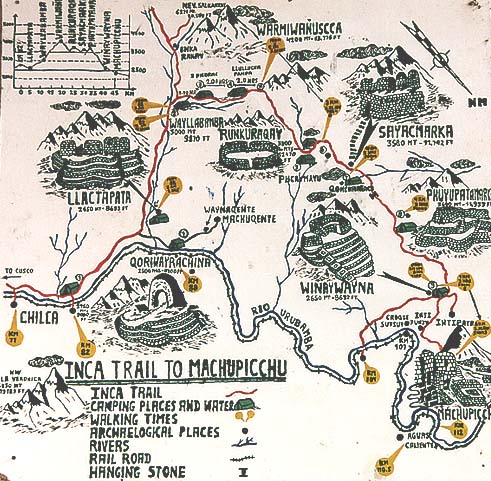 excellent. More important to us, the trip she described involved hiking the Inca Trail
in order to enter Machu Picchu. She explained that, in addition to all
we would experience along the hike, the benefit of this was the opportunity
to spend more time at the site, especially in the evening and at sunrise
when there were not the crowds who were bused in each morning and who were
bused out mid–afternoon. We would, of course, have to camp, sleep on the
ground, carry a day pack, have the benefit of guides and porters (to carry
the tents, equipment, propane tanks, etc.). It seemed like exactly what
we were looking for in a trip: new places, exercise, and a group leader
like Cindy, who was organized and great fun to be with. While we couldn’t
go in 2000, we put ourselves on the list for 2001.
excellent. More important to us, the trip she described involved hiking the Inca Trail
in order to enter Machu Picchu. She explained that, in addition to all
we would experience along the hike, the benefit of this was the opportunity
to spend more time at the site, especially in the evening and at sunrise
when there were not the crowds who were bused in each morning and who were
bused out mid–afternoon. We would, of course, have to camp, sleep on the
ground, carry a day pack, have the benefit of guides and porters (to carry
the tents, equipment, propane tanks, etc.). It seemed like exactly what
we were looking for in a trip: new places, exercise, and a group leader
like Cindy, who was organized and great fun to be with. While we couldn’t
go in 2000, we put ourselves on the list for 2001.
Additional
benefits of the trip with Changes in Latitude were the small size of the
group (13 plus Cindy), the range of ages (12–65), and all from Colorado,
most from Boulder County (which turned out to be a plus). Cindy’s selection
of local guides was perfect and, because she went with us, we knew she
would do everything possible to see that we had a great time doing all
the things that had made the trip a good one for her. And she did. We had
a terrific time. Group size and compatibility among trip members are essentials,
but the key is a group leader who understands why people travel and how
to get the most out of a trip. Cindy is first rate!
SOME (FAIRLY) BRIEF HISTORICAL FOOTNOTES
The
history and culture of the group known today as “the Incas” is derived
from myth, new agers,
Spanish historians, oral traditions, and a variety of artifacts the most
remarkable of which are the ruins of cities, roads, buildings, and other
signs that their empire was wealthy and far–reaching. At its height, the
Incas claimed dominion over a strip of land along the west coast of South
America that extended from Colombia over 2,400 miles to southern Chile
and Argentina, far larger than the empires of Alexander or the Aztecs.
Though there were several important cities, the Inca capital was Cusco
(Qosco), Quechua for
“the navel,” the center of the Inca Empire.
The
ancestors of the Incas migrated into the Sacred Valley in the thirteenth
century under legendary Manco Capac and established the city of Cusco.
They consolidated their hold over the region for nearly two hundred years.
It was the fifth of these rulers (there were 13 in all), Inca Roca, who
initially took the title “Inca,” or “emperor.”
The
domain of the Incas remained small until, in the 15th century, Yupanqui,
a son of the Inca Viracocha, and a small cohort of warriors routed an attempted
invasion by an army of Chancas. Although his father still lived and favored
another son for the succession, the people acclaimed the bold young prince
as their new ruler who took the name “Pachacuti.” Beginning in 1438, Pachacuti
resolved to rebuild Cusco as a lasting monument to Inca glory and a ceremonial
center. As he expanded his empire outward from Cusco, he built an immense
stone fortress called Sacsahuaman on the heights above the city. By the
time of his death, Pachacuti and his kin had expanded the empire in all
directions, earning it the Quechua name “Tahuantinsuyu,” the Four Quarters
of the World. His son, Tupa Inca Yupanqui (“the Unforgettable One”) continued
the expansion, more than doubling the size of the empire (approximately
1471–1493). His successor, Huayna Capac,
expanded
the empire to its greatest extent.
In
1525, Inca Huayna Capac died of smallpox, a disease brought by the Spanish
invaders to the New World. Although the Spanish had explored only the northern
fringes of Inca territory at this time, the disease they had brought with
them was already spreading, decimating the Indian population. The efficient
Inca communication system proved to be Huayna Capac’s undoing: the chasqui
(messenger) who brought the Inca news of the appearance of the white men
and their new disease also brought the virus itself.
Huayna
Capac had designated his son Huascar as his heir. When Huascar was invested
as Inca in Cusco, his brother Atahuallpa had stayed behind in the northern
capital of Quito, sending gifts south to Huascar. The newly invested Inca,
however, cut off the noses of his brother’s ambassadors, making it clear
to Atahuallpa that any loyalty to his brother would be similarly rewarded.
Years of bloody warfare between the brothers eventually ensued. Eventually,
Atahuallpa’s army set a trap for Huascar, captured him, sacked Cusco, and
executed Huascar.
Rumors of rich kingdoms and
gilded rulers began to reach the Spaniards soon after they reached the
New World. Cortez’s conquest of Mexico in 1519 raised the level of greed
and excitement to fever pitch, inspiring numerous other expeditions to
various parts of the New World. Between 1522–1533, starting in the north,
Francisco
Pizzaro made three expeditions of exploration and conquest motivated,
like all Spaniards coming to the new world, by the Three Gs: Gold, God,
and Glory. His tiny army of fewer than 150 men subdued an empire of an
estimated 10,000,000 people through stealth, dishonesty, infectious diseases,
Inca naiveté and internal political turmoil—and guns! It took Pizzaro
nearly 40 years to eradicate the empire, but in 1572, the last Inca, Thupaq
Amaru who led an unsuccessful rebellion against the Spanish, was executed
in the main square in Cusco, bringing to a final end one of the most powerful
and influencial—and amazing—groups of people to have lived.
Today, when Incas are mentioned,
the first image is that of Machu Picchu, the city built in just 30 years
and abandoned before the Spanish conquest and presumably never explored
until 1911 when Yale/Harvard scholar
Hiram Bingham was shown the long–rumored
“Lost
City” by a local Quechua:
“The
morning of July 24th dawned in a cold drizzle. Arteaga (a local farmer)
shivered and seemed inclined to stay in his hut. I offered to pay him well
if he showed me the ruins. He demurred and said it was too hard a climb
for such a wet day. But when he found I was willing to pay him a sol, three
or four times the ordinary daily wage, he finally agreed to go. When asked
just where the ruins were, he pointed straight up to the top of the mountain.
No one supposed that they would be particularly interesting. And no one
cared to go with me.”
Accompanied
only by Seargeant Carrasco (Bingham’s interpreter) and Arteaga, Bingham
left the camp around 10 am. After a short while the party crossed a bridge
so unnerving that the intrepid explorer was reduced to crawling across
it on his hands and knees. From the river they climbed a precipitous slope
until they reached the ridge at around midday.
Here
Bingham rested at a small hut where they enjoyed the hospitality of a group
of campesinos. They told him that they had been living there for about
four years and explained that they had found an extensive system of terraces
on whose fertile soil they had decided to grow their crops. Bingham was
then told that the ruins he sought were close by and he was given a
guide, the 11 year old Pablito Alvarez, to lead him there.
Bingham
announced his “discovery” in articles and photographs published for the
National Geographic Society and other publications, returned at least one
other time to excavate and clean the vegetation from the principle areas,
and later went into politics and business. He died in 1956.
THE RAINFOREST / LAKE SANDOVAL
LODGE
When
our plane touched down in Puerto Maldonado, we hesitated to leave the plane,
expecting the worst humidity and heat and bugs. We were, after all,
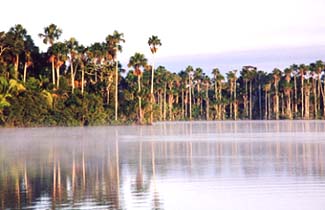 deep in the heart of the southern region of the
great Amazon basin. Puerto Maldonado sits isolated on the banks of the muddy Rio
Madre de Dios which, like hundreds of other rivers on the east slope of the Andes,
eventually makes its way to the great Amazon and the Atlantic Ocean.
deep in the heart of the southern region of the
great Amazon basin. Puerto Maldonado sits isolated on the banks of the muddy Rio
Madre de Dios which, like hundreds of other rivers on the east slope of the Andes,
eventually makes its way to the great Amazon and the Atlantic Ocean.
To our relief
and delight, the temperature was in the 70s, the humidity light (at most
40%), and not a bug in sight. Of course it was winter in Peru, but more
important, we landed in the middle of a “cold spell” that would last for
the three days of our stay.
We
were bused from the airport to the river, boarded a long, narrow “canoe”
with a 55–hp outboard motor, traveled about 45 minutes out of town to a
“landing” where we climbed the dirt bank to the top, hiked about two miles
into the jungle to a spot where a channel had been cut connecting the trail
through a swamp with Lake Sandoval.
Small canoes took us through the swamp and a mile or so across the lake
to a real dock where we climbed the stairs to the lodge and our rooms.
Much like other jungle lodges, the accommodations were clean, comfortable
and no–frill rooms with a private bath and hot water on demand; screens
everywhere (including the ceiling which was open to the other 15 or so
rooms in our wing); and electricity generated from 6–10 am, 12–1 pm, and
6–10 pm. Our beds were covered all around with mosquito netting, but we
didn’t really need them during our time there.
Meals were served in the lodge’s
main building that adjoined the two wings of rooms. Food was local and delicious
(e.g., our first meal, lunch, featured chicken and rice wrapped and steamed in
banana leaves in addition to soup and dessert).
We met our local guide, Javier, at
lunch and spent the afternoon quietly boating on the lake in search of birds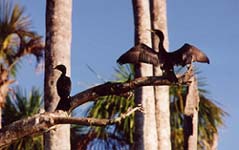 (vultures, egrets,
anhingas,
orapendula,
herons, parrots, macaws, kingfishers, nighthawks, among others),
caimans
(saw only their eyes and then just as red dots at night when the flashlights
struck them), monkeys (howlers, capuchins, squirrels),
giant otters, turtles, and bats.
(vultures, egrets,
anhingas,
orapendula,
herons, parrots, macaws, kingfishers, nighthawks, among others),
caimans
(saw only their eyes and then just as red dots at night when the flashlights
struck them), monkeys (howlers, capuchins, squirrels),
giant otters, turtles, and bats.
Our
routine was to get up at 5:00 am for canoeing around the lake, breakfast,
a hike along one of the trails on the grounds of the lodge for either tree
and animal identification or to learn about medicinal plants. After lunch
was generally free time due to the anticipated heat of the day (though
we usually went out in the canoe on our own). A late afternoon/early evening
group canoe ride around the lake was followed by one of the best times
of the day: a shower followed drinks together in the main lodge (usually
wine or cold beer, but no
pisco
sours since there was no ice available) and a late dinner.
One
variation in our routine was an early morning canoe ride and hike at dawn
to a spot in the jungle Javier knew about where macaws by the hundreds
gather each morning. It was loud and busy with birds getting in each
others’ faces, competing for a particular branch or place on a limb. At
about 7:15, they all get some unseen signal and fly off in family groups
to feed all day.
Lake
Sandoval was an excellent place for photography: animals, trees, different
light conditions and water to reflect everything back on itself. There
is a quietness about the place, a peacefulness that I think we all appreciated
after airport, traffic, airplanes, etc. By our last day, the temperature
began to climb to its normal warmth so that two ice cold beers before lunch
did not seem out of place.
Our experience here was very reminiscent
of our visit to Selva
Verde Lodge in Costa Rica: the setting was identical in many ways—comfortably
rustic, lush vegetation, and lots of exotic plants and birds (plus lots
of butterflies at Selva Verde). Both were very much like Belize, Australia,
and areas we’ve visited in Mexico leading us to suspect that rain forests,
perhaps everywhere, have lots in common.
Beginning
our 16–day trip in this location was a good idea. We’d spent nearly 16
hours on planes, buses, and canoes, and we all needed to slowly stretch
our muscles, not have to deal with big city stress or high altitude (that
would come later), and get to know each other in a relaxing atmosphere.
The group of 14 is very congenial, comfortable, considerate, and uncomplaining.
We would get along famously for the next two weeks!
CUSCO AND THE SACRED VALLEY
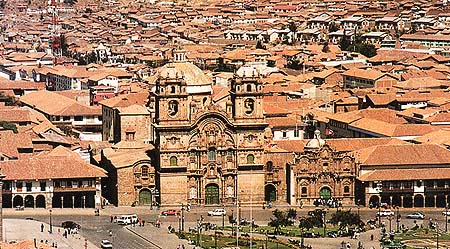 There are reminders of the Incas throughout the city of Cusco. When the
Spanish arrived in 1533 it was a city as modern as most any in the world; within
a few brief years, churches were built from (and on) Inca walls and temples
in a concentrated effort to destroy the old gods and create a Spanish colonial
town on the ruins of the Inca capital. The cathedral of Cusco (shown on the left and below)
faces the Plaza de Armas in the center of the city. In 1983 it was, along with Machu Picchu,
the first of ten locations in Peru to be declared
a World
Heritage Site. During our few days there, we visited both Inca and
Spanish sites aware that both traditions are very much alive.
There are reminders of the Incas throughout the city of Cusco. When the
Spanish arrived in 1533 it was a city as modern as most any in the world; within
a few brief years, churches were built from (and on) Inca walls and temples
in a concentrated effort to destroy the old gods and create a Spanish colonial
town on the ruins of the Inca capital. The cathedral of Cusco (shown on the left and below)
faces the Plaza de Armas in the center of the city. In 1983 it was, along with Machu Picchu,
the first of ten locations in Peru to be declared
a World
Heritage Site. During our few days there, we visited both Inca and
Spanish sites aware that both traditions are very much alive.
Just
a half block from the small Plaza Cusipata is El
Hotel Picoaga, originally the opulent residence of the Marquis de Picoaga
and later converted into a comfortable four star hotel that surrounds an
inner courtyard. The location gave us great access to the central Plaza
de Armes, the Cathedral, shopping, and not a few street vendors who camped
out on the sidewalk just outside the hotel entrance.
Our first afternoon was spent on a
city tour, 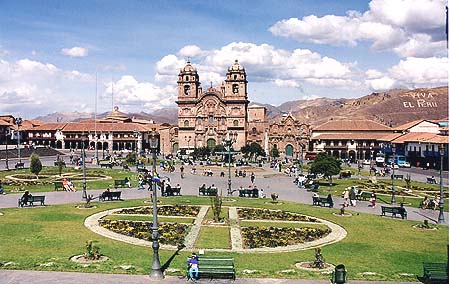 primarily
several of the 40+ churches that serve the residents of Cusco, including
Santo Domingo with its Spanish wall built upon the huge Inca stones so
carefully carved, notched, and set smoothly upon each other; San Blas with
its ornate wood pulpit so intricately carved; and the cathedral which is
undergoing extensive renovation, a project of several years and many millions
of soles (financed in large part by the Peruvian telephone company which,
we were assured, accounted for why the telephone rates were so high). We
had hoped to see, in addition to the gold and silver altar pieces and fine
sculptures, the Spanish–Inca rendition of the Last Supper painted in part
by a traditional Spanish master, and in part by local Quechua painters
who painted in a local delicacy, cuy
or guinea pig, as the main course! Unfortunately, the area of the painting
was off limits to visitors.
primarily
several of the 40+ churches that serve the residents of Cusco, including
Santo Domingo with its Spanish wall built upon the huge Inca stones so
carefully carved, notched, and set smoothly upon each other; San Blas with
its ornate wood pulpit so intricately carved; and the cathedral which is
undergoing extensive renovation, a project of several years and many millions
of soles (financed in large part by the Peruvian telephone company which,
we were assured, accounted for why the telephone rates were so high). We
had hoped to see, in addition to the gold and silver altar pieces and fine
sculptures, the Spanish–Inca rendition of the Last Supper painted in part
by a traditional Spanish master, and in part by local Quechua painters
who painted in a local delicacy, cuy
or guinea pig, as the main course! Unfortunately, the area of the painting
was off limits to visitors.
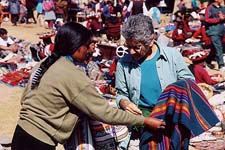 The next two days were spent outside Cusco visiting important Inca
sites with our guide, Fredy Delgado, who would be with us the rest of the trip. On
Sunday, July 1, we headed to Ollantaytambo, a fortress–city on the Urubamba
River about 45 miles northwest of Cusco. On the way, we passed the Sunday
market in the small town of Chinchero.
We smelled bargains and saw photos that needed to be taken, so we stopped
for an hour or so. We continued over the mountains to Urubamba and on to
Ollantaytambo. The origin of the place name is likely fiction, but it makes
a wonderfully romantic tale nonetheless and is worth repeating:
The next two days were spent outside Cusco visiting important Inca
sites with our guide, Fredy Delgado, who would be with us the rest of the trip. On
Sunday, July 1, we headed to Ollantaytambo, a fortress–city on the Urubamba
River about 45 miles northwest of Cusco. On the way, we passed the Sunday
market in the small town of Chinchero.
We smelled bargains and saw photos that needed to be taken, so we stopped
for an hour or so. We continued over the mountains to Urubamba and on to
Ollantaytambo. The origin of the place name is likely fiction, but it makes
a wonderfully romantic tale nonetheless and is worth repeating:
Ollantay
was an officer in the army of Inca Pachacuti who rebelled against Pachacuti
because he was in love with Pachacuti’s daughter and was denied her hand
in marriage. He took refuge in the town of Tampu (meaning shelter
or stopping place) and declared himself the new Inca. The “rebellion” was
quickly crushed, Ollantay was sent to prison, but not before Pachacuti’s
daughter bore a child named Ima Sumaq (also the name taken by a remarkable
Peruvian singer: Yma Sumac).
When Pachacuti died, the next Inca, Tupa Inca Yupanqui, pardoned Ollantay
and allowed the marriage. The town became known thereafter as Ollantaytambo
and the statue of Ollantay stands in the center of town.
We visited a modest home in town with guinea
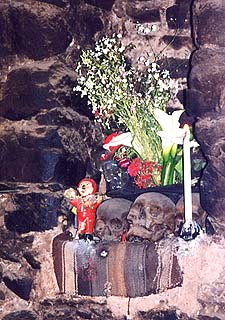 pigs skittering about the floor (future dinners, perhaps?), skulls of family
members on a cornice shelf, and an ekeko
(the figure in red on the right) for good luck. From town we climbed the
terraces and walls of what the Spanish called “The Fortress” that was an
easily defended position built out of huge porphyry monoliths, some over
12 feet high and weighing many tons. They were quarried over six miles
away on the other side of the Urubamba River.
pigs skittering about the floor (future dinners, perhaps?), skulls of family
members on a cornice shelf, and an ekeko
(the figure in red on the right) for good luck. From town we climbed the
terraces and walls of what the Spanish called “The Fortress” that was an
easily defended position built out of huge porphyry monoliths, some over
12 feet high and weighing many tons. They were quarried over six miles
away on the other side of the Urubamba River.
Our
next stop, after a late lunch, was the picturesque market town of Pisac
(P’isaq). The Inca town of Pisac lies in ruins on the hillsides above the
town; today’s Pisac was created by the Spanish to contain the conquered
Quechua in one place in order to indoctrinate them into the Spanish religion
and to control them as laborers for the Spanish settlements. The name Pisac
means “reduction of Indians,” something the Spanish came prepared to do.
The famous Pisac market is a Sunday event, though the shops/stalls appear
more permanently constructed like an on–going flea market. While it was
fun to poke through the endless supply of sweaters, clay figurines, rugs,
etc., it was late in the day, rain threatened, and the vendors seemed tired
and listless. The morning stop at the outdoor market at Chinchero was much
more lively and almost festive.
Though
we were only 18 miles from Cusco, the trip at dusk over the mountains seemed
five times longer. We returned tired, some of us suffering from slight
stomach upset and hastened to our rooms for a rest and some Cipro or Immodium.
A good night’s sleep helped.
The next day we traveled
by bus a short ways out of town to the ruins of
Saqsaywaman
(or “sexy woman,” 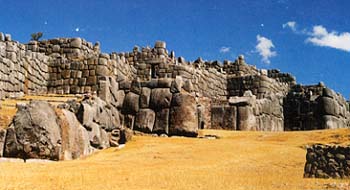 as
the local guides suggest in a smarmy helpful way). The enormous walls are
comprised of massive granite monoliths that measure up to 16 feet high
and wide and weight up to 130 tons; it is a testimony to the engineering
genius of the Incas that they were able to cut, move, and place these stones
with the kind of precision that remains. There are a number of theories
regarding the purpose of the site: was it a castle? a fortress? a fortified
temple and city? or a complex suburb of Cusco? Whatever it was, what remains
staggers the imagination to explain how it came to be constructed. Walking
among the remaining walls is to walk as an ant in a boulder field. Along
with the massive ruins at Ollantaytambo, Saqsaywaman gave us a glimpse
of what we were to find at Machu Picchu and along the four day hike on
the Inca Trail.
as
the local guides suggest in a smarmy helpful way). The enormous walls are
comprised of massive granite monoliths that measure up to 16 feet high
and wide and weight up to 130 tons; it is a testimony to the engineering
genius of the Incas that they were able to cut, move, and place these stones
with the kind of precision that remains. There are a number of theories
regarding the purpose of the site: was it a castle? a fortress? a fortified
temple and city? or a complex suburb of Cusco? Whatever it was, what remains
staggers the imagination to explain how it came to be constructed. Walking
among the remaining walls is to walk as an ant in a boulder field. Along
with the massive ruins at Ollantaytambo, Saqsaywaman gave us a glimpse
of what we were to find at Machu Picchu and along the four day hike on
the Inca Trail.
INCA TRAIL AND MACHU PICCHU
Finally we began the journey
that had brought us to Peru. The Amazon jungle gave us a chance to relax
from the flight and get to know each other in a new setting. The four days
in Cusco gave us some altitude experience and a preview of the Inca Empire
crown jewel, Machu Picchu. Getting there was as important to us as our
arrival.
We began by boarding a 7:30
train in Cusco. We cleared the city after six switch backs, passed through
fertile farming areas, caught glimpses of Mount Veronica (nearly 19,000'),
passed by Ollantaytambo at Km 68, and finally arrived at Km 88, a nondescript
siding where we got off, collected our belongings, signed in at the official
registration point, crossed a footbridge over the Rio Urubamba, and walked
less than a mile to our first campsite at Qente, near the ruins of Llaqtapata,
an agricultural city with terraces for growing, temples, residences, and
a wall paralleling the Kusichaka River. We enjoyed a hearty lunch and a
five mile warm–up hike through a eucalyptus grove and onto the main trail
we would go back over again in the morning. Before dinner some rested in
their tents while a few fierce competitors in our group joined the guides
and some local flat bellied twentysomethings in several tough games of
soccer until dark.
Our first full day on the
Inca Trail was the equivalent of hiking to the top of Longs Peak (about
4000' elevation gain in just over seven miles). The day was generally cloudy
and we would climb continually before reaching camp at Llulluchapampa just below
Warmiwanusqua 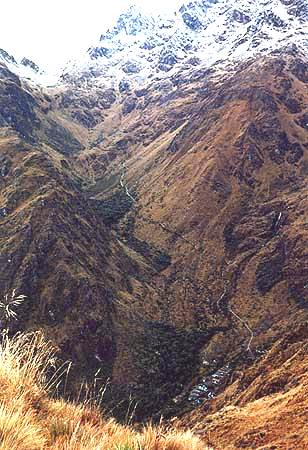 (Dead
Woman Pass) the highest pass on the Trail at 13,780'. We stopped for a
short rest at Willkaraqay, a pre–Spanish village—the last place to buy
anything, we thought—and pushed ever upwards along the wide stone trail.
A couple of our group completed the 2–3 mile leg of the trip by horseback!
The air was thin, and the views of the snow–capped peaks were breathtaking.
We stopped for lunch about 11:15 at a table set up before our arrival by
the cooks and a few porters (the rest had gone on to set up camp at Llulluchapampa)
overlooking the valley from which we had just climbed. Another hour of
ascent through a lush cloud forest and we arrived at camp, a bit tired
but exhilarated by the view at 12,000'. Judy was first in; Hughes was in
the back of the pack as usual. We rested in our tents for a couple of hours
(we really should have brought a book) until “tea” at about 3:30. Fredy
was somehow able to get (in the middle of nowhere!) a six pack of cokes
which some found more to our liking than instant coffee or teas.
(Dead
Woman Pass) the highest pass on the Trail at 13,780'. We stopped for a
short rest at Willkaraqay, a pre–Spanish village—the last place to buy
anything, we thought—and pushed ever upwards along the wide stone trail.
A couple of our group completed the 2–3 mile leg of the trip by horseback!
The air was thin, and the views of the snow–capped peaks were breathtaking.
We stopped for lunch about 11:15 at a table set up before our arrival by
the cooks and a few porters (the rest had gone on to set up camp at Llulluchapampa)
overlooking the valley from which we had just climbed. Another hour of
ascent through a lush cloud forest and we arrived at camp, a bit tired
but exhilarated by the view at 12,000'. Judy was first in; Hughes was in
the back of the pack as usual. We rested in our tents for a couple of hours
(we really should have brought a book) until “tea” at about 3:30. Fredy
was somehow able to get (in the middle of nowhere!) a six pack of cokes
which some found more to our liking than instant coffee or teas.
In the morning some of us
made a quick hike up toward the summit of Dead Woman Pass before breakfast
for some early morning photos. After breakfast, we got no more than 100
yards from camp when the rain began and lasted all day. It was a tough
day for hiking: we climbed to the Pass and then dropped down to Pacaymayu
(a popular/crowded camp area with flush toilets) and then back up again
to Runkuracay, an Inca lookout post at over 12,000' with outstanding views
both down to the valley we’d just climbed from and out to the crest of
the Andes. (The photo on the right shows the trail from the top of the
pass down to Pacaymayu and up to near Runkuracay.) We continued to climb
up to nearly 13,000' before making camp at on the edge of the mountain
near some alpine ponds. In spite of the weather and the tough climb, we
made good time and not a one complained.
In the morning the cook
prepared a special birthday cake for one of our group and several of the
porters picked a huge bouquet of alpine flowers for her as well. It was
a very special occasion and may have accounted for a change in the weather
for the day: no rain! We left camp and climbed to Sayaqmarca (11,472')
a military city at a strategic site on the trail: great views and a defensible
position. Fredy gave us the history of the site and we walked leisurely
around the ruins before heading to 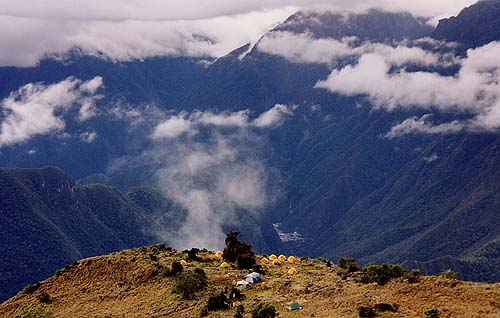 our
final camp near Puyupatamarca. Along the way, the vegetation changed from
alpine to a humid cloud forest environment with several varieties of orchids
mixed in with other flowers and lush greenery. Our camp that night (shown on the left)
was no less spectacular than the previous ones: views of the high peaks were
uninterrupted and dramatic, and we could look down on the town of Aguas
Calientes and Urubamba River over 3000' below.
our
final camp near Puyupatamarca. Along the way, the vegetation changed from
alpine to a humid cloud forest environment with several varieties of orchids
mixed in with other flowers and lush greenery. Our camp that night (shown on the left)
was no less spectacular than the previous ones: views of the high peaks were
uninterrupted and dramatic, and we could look down on the town of Aguas
Calientes and Urubamba River over 3000' below.
Our easiest day of hiking was our final
descent into Machu
Picchu: it was no more than five miles, almost all downhill, and the
rain that persisted throughout the morning and early afternoon stopped
just as we approached the western entrance, a suddenly near vertical stairway
to Intipunku, “The Doorway of the Sun.” Machu Picchu spread out beyond
and below us in all its drama and beauty. We had reached our goal and everyone
rejoiced for we knew that we were all within a half hour of the
Machu
Picchu Sanctuary Lodge, a 3–star accommodation with hot showers, fluffy
towels, a luxuriant queen size bed, and a bar with ice!
The spectacle of Machu Picchu
drew us in and we didn’t rush to the hotel. Rather we immersed ourselves
in the totality of the site: the remains of a major city and remarkable
architectural achievement that must rival any city in the world. The spire
of Huayna Picchu
(meaning “young peak”)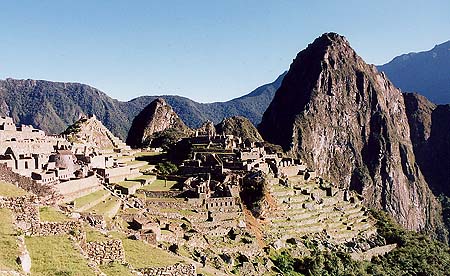 in the background drew the attention of those of us who were planning to
make that difficult climb the next day. Finally, we gave in to the desire
for some creature comforts at the lodge and some much needed rest and change
into dry clothing. Pisco sours, wine, and beer preceded a fine dinner while
we told stories and recounted all we had seen and done for the past four
days. Needless to say, we all felt a great sense of accomplishment.
in the background drew the attention of those of us who were planning to
make that difficult climb the next day. Finally, we gave in to the desire
for some creature comforts at the lodge and some much needed rest and change
into dry clothing. Pisco sours, wine, and beer preceded a fine dinner while
we told stories and recounted all we had seen and done for the past four
days. Needless to say, we all felt a great sense of accomplishment.
A wake–up call at 5:00 am
got us up to view the ruins as the sun came up, a sacrifice we gladly made
to see the light and clouds change the setting from moment to moment. After
breakfast, Fredy, who had been a guide at Machu Picchu a few years earlier,
dusted off his tour and introduced us to much of the ruins until midmorning,
when the group split into those who would continue to explore the city
ruins and those who would climb Huayna Picchu (the mountain that is often
mistaken for Machu Picchu, which is the mountain on which is carved out
the city itself). Ruth Wright, in her detailed and very useful The
Machu Picchu Guidebook (Johnson Books, Boulder: 2001), says
to plan one hour to the top and a half hour down with an additional two
hours or so to appreciate the views as well as the ruins on are on the
top of what appears to be an inaccessible mountain top. We must have hurried,
but we felt the accomplishment of the climb and were thankful for the occasional
rope or chain to help us up the the very steep and narrow stairs. Coming
down was as arduous as the climb!
We left that afternoon by
bus to the little town of Aguas
Calientes: five miles of zigzagging dirt road, though only a mile and
a half straight down, the distance run by a nine–year–old boy who met us
at every crossing, waved and yelled, and ran on, eventually meeting us
at the bottom to collect his gratuity for a fine performance that he really
earned. We ate lunch in Aguas Calientes and caught the trail for Cusco.
In Ollantaytambo, we switched over to a bus which didn’t seem to make the
trip any faster than the train, and we arrived after dark at our hotel.
The following day was spent
on our own—packing, shopping, resting, and getting ready to leave for
home. That evening we celebrated the third birthday on the trip: One of
our group turned 15, a very special birthday in Latin America.
A quinceanera
celebration marks the transition from childhood to womanhood. Cindy, with
the help of several others, planned an elaborate ceremony/party at the
hotel complete with candles, carnations, and music for dancing. It was
a highlight for us all.
Our final day in Peru was
spent flying a delayed flight to Lima, taking a quick tour of downtown
(clogged with incredible traffic, thick diesel fumes, and a gray sky that
was less than cheery) and the Gold Museum. Because of the late flight—a
common occurrence in Peruvian aviation—our visit was rushed. We finished
the evening with a splendid farewell dinner at what has to be Cindy’s favorite
Lima restaurant, La Rosa Nautica, perched on a pier on the Pacific Ocean.
The surroundings were elegant and the seafood was delicious.
And it let us forget what
was ahead for us all: the red–eye flight to Dallas–Ft. Worth and on to
Denver.
SOME FINAL THOUGHTS
Machu Picchu is worth every
nickel, every minor hardship, and every stone along the Inca Trail to see
it. While it is possible to arrive at the this incredible place by train
and bus, the hike—which can be done anywhere from 3–8 days, according
to various tour operators—is an experience unto itself and should not
be missed if at all possible. In our group we had two teenage girls who
never complained nor whined, even when cold and wet and tired (at least publicly).
There were several artificial hips and knees among us, in addition to marathon
runners 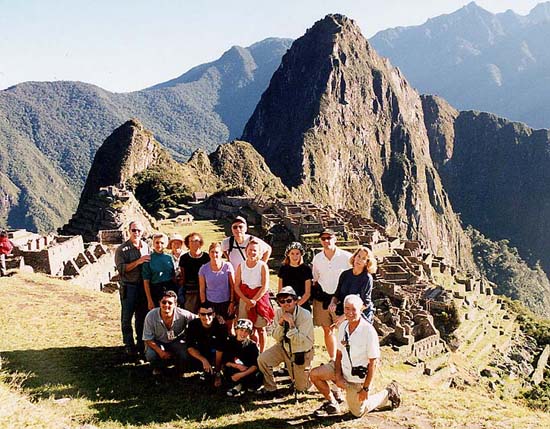 and rock climbers. Heck, Fredy and Percy,
our guides, make the trip more than a dozen times a year. Our strongest advice, if
you can possibly do it, do it!
and rock climbers. Heck, Fredy and Percy,
our guides, make the trip more than a dozen times a year. Our strongest advice, if
you can possibly do it, do it!
Our sincere thanks
Cindy for attracting “the right people” to make
our experience memorable; to Jim
and Austin who proved persistence and
inner strength count for plenty; to Merilee
and Lorilee who reminded us once again
that traveling with young people can be enriching and insightful; to
Jim and Patience
who share such wonderful experiences with their children (and who know how to shop); to
Joe, Sharon, Caroline, Alan, Cheryl who were,
like the others, cheerful, considerate, and great fun to be with for 16 days.
And to guides Fredy and
Percy who kept us moving, kept us organized,
and kept us informed every step of the way—we’re sorry you can’t be with us for
the “Pictures and Pisco Sours Party.” We’ll remember you all.
 finally the last leg of 45 minutes
to Puerto
Maldonado, a town of about 30,000 situated on the Rio Madre de Dios
near the borders of Brasil and Bolivia. After three days at
the Lake Sandoval Lodge in the Amazon rain forest,
we returned to Cusco where we explored the city (of about 250,000) and
the Sacred
Valley for four days. A train took us up the Urubamba River to Kilometer
88 where we began our four day hike on
the Inca
Trail (called the most popular hike in the world)
to Machu
Picchu, the most visited attraction in South America. After two days
at the Inca city, we returned to Cusco by train and bus for a day of R
& R. On our final day we flew to Lima for a city tour and farewell
dinner before boarding the plane for Dallas–Ft. Worth and on to Denver.
finally the last leg of 45 minutes
to Puerto
Maldonado, a town of about 30,000 situated on the Rio Madre de Dios
near the borders of Brasil and Bolivia. After three days at
the Lake Sandoval Lodge in the Amazon rain forest,
we returned to Cusco where we explored the city (of about 250,000) and
the Sacred
Valley for four days. A train took us up the Urubamba River to Kilometer
88 where we began our four day hike on
the Inca
Trail (called the most popular hike in the world)
to Machu
Picchu, the most visited attraction in South America. After two days
at the Inca city, we returned to Cusco by train and bus for a day of R
& R. On our final day we flew to Lima for a city tour and farewell
dinner before boarding the plane for Dallas–Ft. Worth and on to Denver.
 excellent. More important to us, the trip she described involved hiking the Inca Trail
in order to enter Machu Picchu. She explained that, in addition to all
we would experience along the hike, the benefit of this was the opportunity
to spend more time at the site, especially in the evening and at sunrise
when there were not the crowds who were bused in each morning and who were
bused out mid–afternoon. We would, of course, have to camp, sleep on the
ground, carry a day pack, have the benefit of guides and porters (to carry
the tents, equipment, propane tanks, etc.). It seemed like exactly what
we were looking for in a trip: new places, exercise, and a group leader
like Cindy, who was organized and great fun to be with. While we couldn’t
go in 2000, we put ourselves on the list for 2001.
excellent. More important to us, the trip she described involved hiking the Inca Trail
in order to enter Machu Picchu. She explained that, in addition to all
we would experience along the hike, the benefit of this was the opportunity
to spend more time at the site, especially in the evening and at sunrise
when there were not the crowds who were bused in each morning and who were
bused out mid–afternoon. We would, of course, have to camp, sleep on the
ground, carry a day pack, have the benefit of guides and porters (to carry
the tents, equipment, propane tanks, etc.). It seemed like exactly what
we were looking for in a trip: new places, exercise, and a group leader
like Cindy, who was organized and great fun to be with. While we couldn’t
go in 2000, we put ourselves on the list for 2001.
 deep in the heart of the southern region of the
great Amazon basin. Puerto Maldonado sits isolated on the banks of the muddy Rio
Madre de Dios which, like hundreds of other rivers on the east slope of the Andes,
eventually makes its way to the great Amazon and the Atlantic Ocean.
deep in the heart of the southern region of the
great Amazon basin. Puerto Maldonado sits isolated on the banks of the muddy Rio
Madre de Dios which, like hundreds of other rivers on the east slope of the Andes,
eventually makes its way to the great Amazon and the Atlantic Ocean.
 (vultures, egrets,
(vultures, egrets,
 There are reminders of the Incas throughout the city of Cusco. When the
Spanish arrived in 1533 it was a city as modern as most any in the world; within
a few brief years, churches were built from (and on) Inca walls and temples
in a concentrated effort to destroy the old gods and create a Spanish colonial
town on the ruins of the Inca capital. The cathedral of Cusco (shown on the left and below)
faces the Plaza de Armas in the center of the city. In 1983 it was, along with Machu Picchu,
the first of ten locations in Peru to be declared
a
There are reminders of the Incas throughout the city of Cusco. When the
Spanish arrived in 1533 it was a city as modern as most any in the world; within
a few brief years, churches were built from (and on) Inca walls and temples
in a concentrated effort to destroy the old gods and create a Spanish colonial
town on the ruins of the Inca capital. The cathedral of Cusco (shown on the left and below)
faces the Plaza de Armas in the center of the city. In 1983 it was, along with Machu Picchu,
the first of ten locations in Peru to be declared
a  primarily
several of the 40+ churches that serve the residents of Cusco, including
Santo Domingo with its Spanish wall built upon the huge Inca stones so
carefully carved, notched, and set smoothly upon each other; San Blas with
its ornate wood pulpit so intricately carved; and the cathedral which is
undergoing extensive renovation, a project of several years and many millions
of soles (financed in large part by the Peruvian telephone company which,
we were assured, accounted for why the telephone rates were so high). We
had hoped to see, in addition to the gold and silver altar pieces and fine
sculptures, the Spanish–Inca rendition of the Last Supper painted in part
by a traditional Spanish master, and in part by local Quechua painters
who painted in a local delicacy,
primarily
several of the 40+ churches that serve the residents of Cusco, including
Santo Domingo with its Spanish wall built upon the huge Inca stones so
carefully carved, notched, and set smoothly upon each other; San Blas with
its ornate wood pulpit so intricately carved; and the cathedral which is
undergoing extensive renovation, a project of several years and many millions
of soles (financed in large part by the Peruvian telephone company which,
we were assured, accounted for why the telephone rates were so high). We
had hoped to see, in addition to the gold and silver altar pieces and fine
sculptures, the Spanish–Inca rendition of the Last Supper painted in part
by a traditional Spanish master, and in part by local Quechua painters
who painted in a local delicacy,  The next two days were spent outside Cusco visiting important Inca
sites with our guide, Fredy Delgado, who would be with us the rest of the trip. On
Sunday, July 1, we headed to Ollantaytambo, a fortress–city on the Urubamba
River about 45 miles northwest of Cusco. On the way, we passed the Sunday
market in the small town of
The next two days were spent outside Cusco visiting important Inca
sites with our guide, Fredy Delgado, who would be with us the rest of the trip. On
Sunday, July 1, we headed to Ollantaytambo, a fortress–city on the Urubamba
River about 45 miles northwest of Cusco. On the way, we passed the Sunday
market in the small town of  pigs skittering about the floor (future dinners, perhaps?), skulls of family
members on a cornice shelf, and an
pigs skittering about the floor (future dinners, perhaps?), skulls of family
members on a cornice shelf, and an  as
the local guides suggest in a smarmy helpful way). The enormous walls are
comprised of massive granite monoliths that measure up to 16 feet high
and wide and weight up to 130 tons; it is a testimony to the engineering
genius of the Incas that they were able to cut, move, and place these stones
with the kind of precision that remains. There are a number of theories
regarding the purpose of the site: was it a castle? a fortress? a fortified
temple and city? or a complex suburb of Cusco? Whatever it was, what remains
staggers the imagination to explain how it came to be constructed. Walking
among the remaining walls is to walk as an ant in a boulder field. Along
with the massive ruins at Ollantaytambo, Saqsaywaman gave us a glimpse
of what we were to find at Machu Picchu and along the four day hike on
the Inca Trail.
as
the local guides suggest in a smarmy helpful way). The enormous walls are
comprised of massive granite monoliths that measure up to 16 feet high
and wide and weight up to 130 tons; it is a testimony to the engineering
genius of the Incas that they were able to cut, move, and place these stones
with the kind of precision that remains. There are a number of theories
regarding the purpose of the site: was it a castle? a fortress? a fortified
temple and city? or a complex suburb of Cusco? Whatever it was, what remains
staggers the imagination to explain how it came to be constructed. Walking
among the remaining walls is to walk as an ant in a boulder field. Along
with the massive ruins at Ollantaytambo, Saqsaywaman gave us a glimpse
of what we were to find at Machu Picchu and along the four day hike on
the Inca Trail.
 (Dead
Woman Pass) the highest pass on the Trail at 13,780'. We stopped for a
short rest at Willkaraqay, a pre–Spanish village—the last place to buy
anything, we thought—and pushed ever upwards along the wide stone trail.
A couple of our group completed the 2–3 mile leg of the trip by horseback!
The air was thin, and the views of the snow–capped peaks were breathtaking.
We stopped for lunch about 11:15 at a table set up before our arrival by
the cooks and a few porters (the rest had gone on to set up camp at Llulluchapampa)
overlooking the valley from which we had just climbed. Another hour of
ascent through a lush cloud forest and we arrived at camp, a bit tired
but exhilarated by the view at 12,000'. Judy was first in; Hughes was in
the back of the pack as usual. We rested in our tents for a couple of hours
(we really should have brought a book) until “tea” at about 3:30. Fredy
was somehow able to get (in the middle of nowhere!) a six pack of cokes
which some found more to our liking than instant coffee or teas.
(Dead
Woman Pass) the highest pass on the Trail at 13,780'. We stopped for a
short rest at Willkaraqay, a pre–Spanish village—the last place to buy
anything, we thought—and pushed ever upwards along the wide stone trail.
A couple of our group completed the 2–3 mile leg of the trip by horseback!
The air was thin, and the views of the snow–capped peaks were breathtaking.
We stopped for lunch about 11:15 at a table set up before our arrival by
the cooks and a few porters (the rest had gone on to set up camp at Llulluchapampa)
overlooking the valley from which we had just climbed. Another hour of
ascent through a lush cloud forest and we arrived at camp, a bit tired
but exhilarated by the view at 12,000'. Judy was first in; Hughes was in
the back of the pack as usual. We rested in our tents for a couple of hours
(we really should have brought a book) until “tea” at about 3:30. Fredy
was somehow able to get (in the middle of nowhere!) a six pack of cokes
which some found more to our liking than instant coffee or teas.
 our
final camp near Puyupatamarca. Along the way, the vegetation changed from
alpine to a humid cloud forest environment with several varieties of orchids
mixed in with other flowers and lush greenery. Our camp that night (shown on the left)
was no less spectacular than the previous ones: views of the high peaks were
uninterrupted and dramatic, and we could look down on the town of Aguas
Calientes and Urubamba River over 3000' below.
our
final camp near Puyupatamarca. Along the way, the vegetation changed from
alpine to a humid cloud forest environment with several varieties of orchids
mixed in with other flowers and lush greenery. Our camp that night (shown on the left)
was no less spectacular than the previous ones: views of the high peaks were
uninterrupted and dramatic, and we could look down on the town of Aguas
Calientes and Urubamba River over 3000' below.
 in the background drew the attention of those of us who were planning to
make that difficult climb the next day. Finally, we gave in to the desire
for some creature comforts at the lodge and some much needed rest and change
into dry clothing. Pisco sours, wine, and beer preceded a fine dinner while
we told stories and recounted all we had seen and done for the past four
days. Needless to say, we all felt a great sense of accomplishment.
in the background drew the attention of those of us who were planning to
make that difficult climb the next day. Finally, we gave in to the desire
for some creature comforts at the lodge and some much needed rest and change
into dry clothing. Pisco sours, wine, and beer preceded a fine dinner while
we told stories and recounted all we had seen and done for the past four
days. Needless to say, we all felt a great sense of accomplishment.
 and rock climbers. Heck, Fredy and Percy,
our guides, make the trip more than a dozen times a year. Our strongest advice, if
you can possibly do it, do it!
and rock climbers. Heck, Fredy and Percy,
our guides, make the trip more than a dozen times a year. Our strongest advice, if
you can possibly do it, do it!
